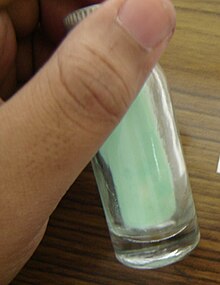Löwenstein-Jensen

Löwenstein-Jensen medium used for growing M. tuberculosis in a McCartney bottle.
|
|
| Acronym | LJ medium |
|---|---|
| Uses | Culturing |
| Related items |
Petri dish Growth medium |
The Löwenstein–Jensen medium, more commonly known as LJ medium, is a growth medium specially used for culture of Mycobacterium species, notably Mycobacterium tuberculosis.
When grown on LJ medium, M. tuberculosis appears as brown, granular colonies (sometimes called "buff, rough and tough"). The medium must be incubated for a significant length of time, usually four weeks, due to the slow doubling time of M. tuberculosis (15–20 hours) compared with other bacteria.
The usual composition as applicable to M. tuberculosis is:
The original formulation included starch, which was later found to be unnecessary, so omitted.
Low levels of penicillin and nalidixic acid are also present in LJ medium to inhibit growth of Gram-positive and Gram-negative bacteria, to limit growth to Mycobacterium species only. Presence of malachite green in the medium inhibits most other bacteria. It is disinfected and solidified by a process of inspissation. Presence of glycerol enhances the growth of M. tuberculosis.
If the slopes are made on test tubes, they must be stored in cold and used within a month.
For cultivation of M.bovis, glycerol is omitted and sodium pyruvate is added.
The medium appears green, opaque, and opalescent.
While the LJ medium is the most popular means of culturing mycobacteria, as recommended by the International Union against Tuberculosis, several alternative media have been investigated.
The chief limitation of culture-based techniques is the time it takes to culture positivity, which can be several months. Several new molecular technologies have emerged in recent years to secure more speedy confirmation of diagnosis.
...
Wikipedia
